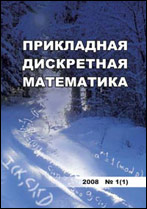|
Computational Methods in Discrete Mathematics
Associative memory based on cellular neural networks with bipolar stepwise activation function
M. S. Tarkov
Rzhanov Institute of Semiconductor Physics SB RAS, Novosibirsk, Russia
Abstract:
Cellular neural networks (CNN) with a bipolar stepwise activation function are considered as obtained by training on a given set of binary reference images. The trained CNN versions with the different cell neighborhood sizes were tested in solving the problem of filtering noisy reference images. It has been established that global training methods (the Hebb method and the projection method), traditionally used in Hopfield networks, generate high-level noise (tens of percent) at the output of cellular networks even in the absence of input noise. A local analogue of the projection method is proposed that provides the filtering of noisy images significantly better than the classical local perceptron learning algorithm. The local Hebb method works better than the above two methods only with minimal neighborhood and high noise levels ($70 \%$ at least). The influence of the CNN weights quantization levels number on the CNN information capacity is investigated. It is shown that: 1) with the number of quantization levels greater than $8$ and the number of neurons $16\times 16$, the capacity of the CNN with quantized weights, trained according to the local Hebb rule, approximates the capacity of the CNN with continuous weights; 2) when using the local projection method, a similar result is achieved with a number of levels not less than $64$.
Keywords:
cellular neural networks, noise filtering, perceptron training algorithm, local projection method, cell neighborhood, informational capacity of cellular neural network, weight quantization.
Citation:
M. S. Tarkov, “Associative memory based on cellular neural networks with bipolar stepwise activation function”, Prikl. Diskr. Mat., 2020, no. 48, 100–108
Linking options:
https://www.mathnet.ru/eng/pdm708 https://www.mathnet.ru/eng/pdm/y2020/i2/p100
|

| Statistics & downloads: |
| Abstract page: | 242 | | Full-text PDF : | 79 | | References: | 32 |
|




 Contact us:
Contact us: Terms of Use
Terms of Use
 Registration to the website
Registration to the website Logotypes
Logotypes








 Citation in format
Citation in format 